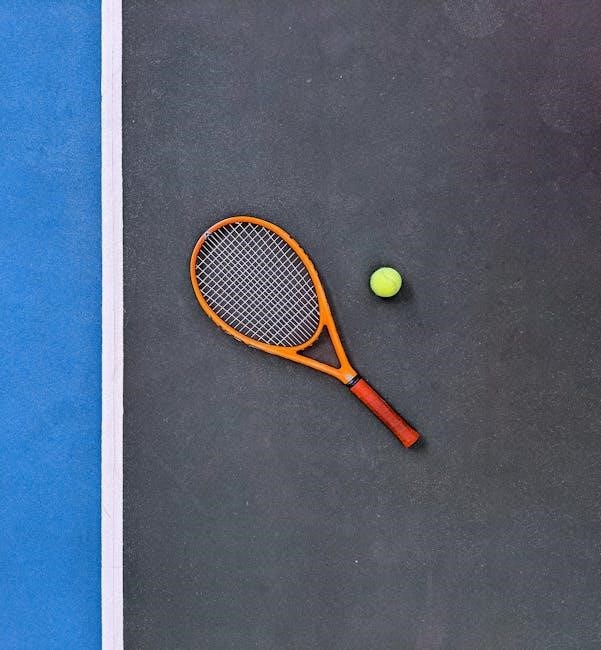
String tension is crucial for optimizing racket performance, balancing power, control, and comfort. Understanding and selecting the right tension can elevate your game and reduce errors significantly.
1.1 What is String Tension?
String tension refers to the tightness of the strings in a tennis racket, measured in pounds (lbs). It determines how the racket performs, influencing power, control, and comfort. Proper tension balances these elements, ensuring optimal play. Higher tension provides more control but less power, while lower tension increases power but reduces precision. The right tension depends on a player’s style, skill level, and string material. Understanding and adjusting string tension is key to maximizing performance and comfort on the court. It’s a critical factor in customizing a racket to suit individual preferences and playing needs.
1.2 Why is String Tension Important?
String tension is vital as it directly impacts a player’s performance, influencing power, control, and comfort. Proper tension ensures optimal racket responsiveness, allowing players to execute shots effectively. It helps reduce errors and enhances precision, making it easier to hit winners. Additionally, the right tension minimizes arm strain, promoting longevity in play. By balancing power and control, string tension tailors the racket to a player’s style, skill level, and preferences. This customization is essential for maximizing potential and achieving consistent results on the court, making string tension a cornerstone of racket setup and performance optimization.
Factors Influencing String Tension
String tension is shaped by playing style, skill level, string material, and gauge, each contributing to the balance between power, control, and comfort for optimal performance.
2.1 Playing Style and Its Impact on Tension
Your playing style significantly influences the ideal string tension. Aggressive players who hit hard benefit from lower tension for more power, while control-oriented players prefer higher tension for precision. Those with a balanced style often opt for medium tension. The frequency and type of shots, such as topspin or slices, also play a role. Understanding your style helps tailor tension to enhance performance, ensuring the right blend of power and control. This customization is key to optimizing your racket’s responsiveness and your overall game effectiveness.
2.2 Skill Level and Tension Requirements
Skill level plays a key role in determining optimal string tension. Beginners often benefit from lower tension, which provides more power and comfort, reducing arm strain. Intermediate players typically prefer medium tension, offering a balance between power and control. Advanced players, who prioritize precision, often choose higher tension. As skill improves, players tend to adjust tension to match their evolving needs. Understanding your skill level helps tailor tension to enhance performance, ensuring the racket responds appropriately to your strokes. This customization is essential for maximizing both effectiveness and comfort on the court.
2.3 String Material and Its Effect on Tension
String material significantly influences tension and performance. Polyester strings are durable and maintain tension well, offering control and spin. Nylon strings provide comfort and power but lose tension faster. Natural gut strings deliver exceptional feel and power but are less durable. Hybrid setups combine materials for balanced play. The choice of material affects how tension impacts the racket’s response. Players must consider their material’s characteristics to align with their desired tension and playing style. This ensures optimal performance, as different materials respond uniquely to tension adjustments, influencing power, control, and comfort during gameplay.
2.4 String Gauge and Its Role in Tension
String gauge, or thickness, plays a significant role in determining tension and performance. Thicker strings (lower gauge) are more durable and provide greater power but less control; Thinner strings (higher gauge) offer more spin and precision but are less durable. The gauge affects how tension is experienced, as thinner strings at high tension can feel brittle, while thicker strings at lower tension are more forgiving. Players must balance gauge with tension to suit their style, ensuring optimal performance without sacrificing comfort or durability. This balance is key to achieving the desired feel and response from the racket during play.

General Guidelines for String Tension
General guidelines for string tension help players balance power, control, and comfort. These recommendations serve as a starting point, allowing adjustments based on personal preference and style.
3.1 Lower Tension: Power and Comfort

Lower string tension provides more power and comfort, making it ideal for players seeking to maximize energy transfer and reduce arm strain. With looser strings, the ball trampolines off the racket, generating additional power. This setup is particularly beneficial for intermediate players or those with slower swing speeds, as it enhances shot depth and consistency. Additionally, lower tension softens the impact on the arm, reducing discomfort and the risk of injury. However, it may compromise control, so finding the right balance is essential for optimal performance.
3.2 Medium Tension: Balance of Power and Control
Medium string tension strikes a balance between power and control, making it a versatile choice for most players. It offers sufficient energy transfer for powerful shots while maintaining precision and consistency. This tension is ideal for all-around players who value both aggression and finesse. Medium tension also provides a comfortable playing experience, reducing arm strain compared to higher tensions. It suits players with moderate swing speeds, offering a blend of performance benefits that cater to a wide range of playing styles and preferences, making it a popular choice among both amateur and professional players seeking reliability and adaptability.
3.3 Higher Tension: Precision and Control
Higher string tension reduces power but enhances precision and control, making it ideal for advanced players with strong techniques. It minimizes string movement, providing consistent ball response and sharper angles. This tension is favored by players who prioritize accuracy and finesse over raw power. However, it can lead to reduced comfort and increased arm strain for those with slower swing speeds. Higher tension demands precise timing and is often chosen by professionals seeking maximum control in competitive play, allowing for precise shot placement and reliable performance under pressure.
Understanding the Impact of Tension on Performance
String tension significantly affects power, control, and comfort. Proper tension balances these elements, optimizing performance and reducing strain, ensuring a tailored experience for every player’s style and level.
4.1 Power: How Tension Affects Hitting Power
String tension directly influences hitting power. Lower tension allows strings to flex more, generating additional power on impact. This increased flex creates a trampoline-like effect, propelling the ball with greater force. Conversely, higher tension reduces string movement, minimizing power but enhancing control. Players seeking more power often opt for lower tension, especially those with slower swing speeds. However, excessive low tension can lead to inconsistent shots. Balancing power and control through tension adjustment is key to optimizing performance and achieving desired results on the court.
4.2 Control: How Tension Influences Shot Precision
Higher string tension enhances control by reducing string movement, providing a more consistent and precise response. This stability allows for better accuracy and spin management, especially for advanced players with faster swing speeds. Lower tension, while offering more power, can lead to less predictable ball behavior, making it harder to control shots. The right tension balance is essential for maintaining precision without sacrificing power. Players aiming for sharper angles and consistent placement often prefer tighter strings, as they deliver a more reliable performance across various shot types.
4.3 Comfort: How Tension Reduces Arm Strain
Lower string tension provides a softer feel, reducing arm strain and discomfort during play. Softer strings absorb more shock, minimizing the impact on joints and muscles, especially beneficial for players with arm injuries or chronic pain. Higher tension, while offering control, can lead to a stiffer response, increasing strain. Balancing tension is key to maintaining comfort without sacrificing performance. Players with arm sensitivity often opt for lower tension to enjoy a more forgiving racket setup, allowing for longer, pain-free playing sessions and improved overall well-being on the court.

Choosing the Right Tension for Your Game
Optimizing string tension balances power, control, and comfort, tailoring your racket setup to enhance performance and reduce strain, ensuring a personalized feel for every player’s style and needs.
5.1 Assessing Your Playing Style
Evaluating your playing style is the first step in choosing the right string tension. Players who rely on power and spin often prefer lower tension, while those focused on precision and control opt for higher tension. Baseline players may prioritize durability and comfort, whereas serve-and-volley players might seek a balance between power and control. Understanding your style helps tailor your racket setup to your strengths, ensuring optimal performance. Self-assessment or professional guidance can clarify your needs, enabling you to make informed decisions that enhance your game and reduce strain on your arm.
5.2 Considering Your Skill Level
Your skill level significantly influences the ideal string tension. Beginners often benefit from lower tension, as it provides more power and forgiveness, reducing arm strain. Intermediate players may prefer medium tension, balancing power and control. Advanced players typically opt for higher tension, prioritizing precision and spin control. Lower tensions are generally easier on the arm, making them suitable for those developing their strength and technique. As skill improves, players can gradually increase tension to enhance performance. Tailoring tension to your skill level ensures a comfortable and effective playing experience, allowing you to focus on improving your game.
5.3 Selecting the Appropriate String Material
String material plays a key role in determining tension and overall performance. Natural gut offers exceptional power and comfort, making it ideal for lower tensions. Polyester strings are durable and provide control, often used at higher tensions. Nylon strings strike a balance between power and durability, suitable for medium tensions. Hybrid strings combine materials for optimal performance, blending power and control. The choice of material directly impacts how tension affects your game, ensuring a tailored experience based on your playing style and needs. Selecting the right material is essential for achieving the desired balance of power, control, and comfort in your racket.
5.4 Determining the Ideal String Gauge
String gauge, measured in thickness, significantly impacts tension and performance. Thinner gauges (lower numbers) provide more power but are less durable, while thicker gauges (higher numbers) offer durability and control. Lower tensions work well with thinner strings for power, while higher tensions pair with thicker strings for precision. Gauge and tension must be balanced to avoid string breakage or loss of performance. Players should choose gauge based on their style and skill level, ensuring it complements their tension preference for optimal results. This balance ensures a tailored racket setup that enhances both power and control effectively.

Pro Player String Tensions: Insights and Examples
Professional players often use high tensions for precision, while others opt for lower tensions to maximize power. Their choices vary based on style and conditions.
6.1 Tension Preferences of Top Players
Top players’ string tensions vary widely, reflecting their unique styles. Some prefer high tension for control, while others opt for lower tension to generate power. For instance, players with aggressive styles often choose higher tensions to maintain precision, especially on faster surfaces. Conversely, those relying on heavy topspin may lower tension to enhance power and spin. These preferences are finely tuned to their techniques and the demands of different courts, showcasing how tension customization is vital at the elite level. This adaptability highlights the importance of personalizing string tension for optimal performance.
6.2 How Pros Adjust Tension for Different Conditions
Professional players often adjust string tension based on court conditions and weather. On slower surfaces like clay, lower tension is used to maximize power and spin. Conversely, on faster surfaces such as grass or hard courts, higher tension is preferred for control. Humidity and temperature also influence adjustments, as strings lose tension in warmer conditions. Pros fine-tune their setups to maintain performance consistency, ensuring optimal play regardless of environmental factors. These precise adjustments highlight the importance of customization in achieving peak performance at the highest levels of competition.
Step-by-Step Guide to Selecting String Tension
Evaluate your current setup, test different tensions, and adjust based on performance to find the perfect balance of power, control, and comfort for your game.

7.1 Evaluating Your Current Setup
Evaluating your current setup is the first step in optimizing string tension. Assess how your racket feels and performs during matches or practice. Consider factors like power, control, and comfort. Reflect on past performances to identify patterns, such as consistent errors or lack of power. Check the condition of your strings for wear and tear, as this can affect tension. Test the strings by plucking them to gauge tightness. This self-assessment helps determine if your current tension aligns with your playing style and goals, guiding adjustments for improved performance.
7.2 Testing Different Tensions
Testing different tensions is essential to finding your optimal setup. Start by adjusting your string tension in small increments, such as 1-2 pounds, to observe changes in performance. Use a tension meter for accuracy and consistency. Play with each setup during practice sessions, focusing on how the racket feels and performs. Pay attention to power, control, and comfort levels. Record your findings to compare and identify patterns. This hands-on approach ensures you make informed decisions tailored to your game, helping you strike the perfect balance between power and precision.
7.3 Adjusting Tension Based on Performance
Evaluate your racket’s performance during practice to determine if adjustments are needed; If you notice reduced power, consider lowering tension for more string movement. For enhanced control, slightly increase tension. Pay attention to comfort levels; arm strain may indicate tension is too high. Fine-tune in small increments, testing each adjustment thoroughly. Keep track of how changes impact your shots and overall feel. This iterative process ensures your racket is tailored to your unique style and preferences, optimizing power, control, and comfort for peak performance on the court.

Maintaining Optimal String Tension
Regular maintenance ensures consistent performance and longevity of your strings. Monitor tension levels, restring as needed, and watch for signs of wear to keep your racket in top shape.
8.1 How Often to Restring Your Racket
The frequency of restringing depends on usage and string material. Players should restring every 3-6 months or sooner if they notice reduced performance or visible wear. Regular players may need to restring more frequently, especially if they play multiple times a week. Signs like loss of tension, frayed strings, or decreased power indicate it’s time for a new set. Consistent restringing ensures optimal tension, maintaining both performance and comfort. Proper maintenance can extend string life and prevent sudden breakage during critical moments in a match.

8.2 Signs That Your Tension is Off
Recognizing when your string tension is off is vital for maintaining performance. Common indicators include a loss of power, inconsistent shots, and decreased control. If the strings feel too loose or tight, it may affect your gameplay. Visible signs like frayed or worn strings also signal improper tension. Additionally, arm strain or discomfort while playing can be a sign of incorrect tension. Regularly checking these factors ensures your racket remains optimized, providing consistent performance and comfort during matches. Addressing these signs promptly helps prevent further issues and maintains your playing edge.
8.3 The Importance of Regular Maintenance
Regular maintenance is essential to ensure your racket performs optimally and lasts longer. Neglecting upkeep can lead to lost tension, inconsistent performance, and discomfort. Key tasks include restringing, checking tension, and inspecting for wear. Proper care maintains power, control, and comfort while preventing arm strain; Consistent maintenance also extends the life of your strings and racket. By prioritizing regular upkeep, you ensure your equipment remains tailored to your game, providing reliability and peak performance during critical moments. A well-maintained racket is a vital tool for any player aiming to excel on the court.
Tools and Techniques for Measuring Tension
A tension meter is the primary tool for accurate measurements, ensuring optimal string tightness. Manual testing methods, like plucking strings, also help maintain consistency and performance.
9.1 Using a Tension Meter
A tension meter is an essential tool for precise string tension measurement. It ensures accuracy, helping players achieve the perfect balance between power and control. Regular use maintains consistency, preventing over-tightening or under-tightening, which can affect performance. By following the manufacturer’s guidelines, players can easily measure and adjust their strings to the desired tension. This tool is particularly useful for maintaining optimal tension levels, ensuring the racket performs consistently across different playing conditions and styles. Proper use of a tension meter can significantly enhance overall racket performance and player satisfaction.
9.2 Manual Testing Methods
Manual testing methods provide a practical way to assess string tension without specialized tools. Players can pluck the strings to gauge tension by sound and feel. Tighter strings produce a higher pitch, while looser strings sound lower. Additionally, pressing the strings with your fingers can help determine stiffness. Consistent tension across the racket is essential for balanced performance. Regular manual checks ensure strings remain within the desired range, preventing over-tightening or under-tightening. This simple yet effective approach helps maintain optimal playability and extends string lifespan, ensuring consistent performance on the court.

Common Mistakes to Avoid
Common mistakes include over-tightening strings, which reduces power, and underestimating tension’s impact on performance. Ignoring string material and gauge can lead to discomfort and inconsistent play.
10.1 Over-Tightening the Strings
Over-tightening strings is a common mistake that reduces power and comfort. Tight strings can lead to a stiff feel, causing arm strain and discomfort. This tension also diminishes the racket’s ability to generate power, making it harder to hit winners. Additionally, over-tightening can damage the racket frame over time. Players often overlook the balance between control and power, prioritizing one over the other. To avoid this, test different tensions and find a balance that suits your style. Regularly checking and adjusting tension ensures optimal performance and prevents long-term issues. Proper tension maintenance is key to consistent and enjoyable play.
10.2 Underestimating the Impact of Tension
Many players overlook the significance of string tension, assuming it has minimal impact on their game. However, tension plays a critical role in performance, influencing power, control, and comfort. Ignoring proper tension can lead to reduced power, inconsistent shots, or increased arm strain. Players often fail to recognize how tension aligns with their style and level, leading to suboptimal setups. Understanding and adjusting tension can transform your game, making it essential to prioritize its importance. By recognizing tension’s role, you can tailor your racket to enhance performance and achieve better results on the court.
10.3 Ignoring String Material and Gauge
Neglecting string material and gauge is a common mistake that can significantly affect performance. Different materials, such as polyester or natural gut, offer varying levels of durability, power, and feel. Gauge, or thickness, also impacts playability, with thinner strings providing more power and spin but less durability. Players often overlook how these factors interact with tension, leading to imbalanced setups. By understanding material and gauge, you can better align your strings with your playing style and tension preferences, ensuring optimal performance and comfort. Ignoring these elements can hinder your ability to achieve the desired balance of power, control, and durability.
Proper string tension is vital for maximizing performance, balancing power, control, and comfort. Experiment with different setups and maintain your racket to ensure optimal play and longevity.
11.1 Summary of Key Points
String tension significantly impacts a player’s performance, balancing power, control, and comfort. Understanding how tension affects your game is crucial for optimizing racket setup. Players should consider their style, skill level, and equipment to choose the ideal tension. Lower tension offers more power, while higher tension provides precision. Regular maintenance and restringing are essential to maintain optimal play. By experimenting with different tensions and materials, players can tailor their racket to enhance performance and reduce injury risk. Ultimately, the right tension setup can elevate your game and help you achieve your tennis goals.
11.2 Final Tips for Optimizing Your Racket

Experiment with different tensions to find your sweet spot, balancing power, control, and comfort. Consider your playing style, skill level, and string material when making adjustments. Regularly maintain your racket by restringing and checking tension to ensure consistent performance. Don’t hesitate to seek professional advice for custom setups. Remember, the right tension can elevate your game, reduce errors, and enhance your overall tennis experience. Tailor your racket to your unique needs and style for maximum effectiveness on the court.